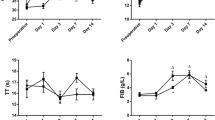Intraoperative blood loss during total knee arthroplasty in patients with hemophilia varies over a wide range (from 300 to 3000 ml). The reasons have not been clarified yet. We studied the dependence of intraoperative blood loss during total knee arthroplasty in patients with hemophilia A on hematocrit and mean erythrocyte density. Intraoperational blood loss ≥1000 ml was observed in patients with hematocrit <38.5%. In patients with hematocrit >38.5% this parameter depended on the mean erythrocyte density: in patients with increased erythrocyte density, the risk of intraoperational blood loss ≥1000 ml was higher. The increase in erythrocyte density can serve as an indicator of pathological processes, including the processes modulating hemostasis. It can also be assumed that erythrocytes with higher density change blood flow, which affects platelet adhesion to the damaged endothelium. Hematocrit below the threshold level and mean density of erythrocytes above the normal level can be regarded as risk factor for increased intraoperational blood loss.
Similar content being viewed by others
References
E. S. Shurkhina, V. M. Nesterenko, N. V. Tsvetayeva, O. F. Nikulina, and F. I. Ataullakhanov, The method of analysis of distribution of erythrocytes by density: practical guidelines. Klin. Lab. Diagnost., 59, No. 7, 41–46 (2014).
P. A. Aarts, A. Bolhuis, K. S. Sakariassen, R. M. Heethaar, and J. J. Sixma, Red blood cell size is important for adherence of blood platelets to artery subendothelium. Blood, 62, No. 1, 214–217 (1983).
M. Eugster and W. H. Reinhart, The influence of the haematocrit on primary haemostasis in vitro. Thromb. Haemost., 94, No. 6, 1213–1218 (2005).
G. Gardos, I. Szasz, and B. Sarkadi, Effect of intracellular calcium on the cation transport processes in human red cells. Acta Biol. Med. Ger., 36, Nos. 5–6, 823–829 (1977).
J. S. Gibson and M. Muzyamba, Modulation of Gardos channel activity by oxidants and oxygen tension: effects of 1-chloro-2,4-dinitrobenzene and phenazine methosulphate. Bioelectrochemistry, 62, No. 2, 147–152 (2004).
R. Haidmayer, T. Kenner, and H. Hinghofer-Szalkay, On the influence of temperature on the measurement of density distribution of erythrocytes. Biomed. Tech. (Berl.), 25, No. 10, 258–260 (1980).
L. Kaestner, W. Tabellion, P. Lipp, and I. Bernhardt, Prostaglandin E2 activates channel-mediated calcium entry in human erythrocytes: an indication for a blood clot formation supporting process. Thromb. Haemost., 92, No. 6, 1269–1272 (2004).
A. Rivera, P. Jarolim, and C. Brugnara, Modulation of Gardos channel activity by cytokines in sickle erythrocytes. Blood, 99, No. 1, 357–603 (2002).
A. Rivera, M. A. Rotter, and C. Brugnara, Endothelins activate Ca(2+)-gated K(+) channels via endothelin B receptors in CD-1 mouse erythrocytes. Am. J. Physiol., 277, No. 4, Pt 1, C746-C754 (1999).
E. S. Shurkhina, S., Shcherbinina, S. V. Kolodei, and T. A. Yermakova, The influence of emoxipin on the red blood cell density at iron disorders. Biomarkers and Environment, 4, Suppl. 1, 4–7 (2001).
T. Tiffert, J. L. Spivak, and V. L. Lew, Magnitude of calcium influx required to induce dehydration of normal human red cells. Biochim. Biophys. Acta, 943, No. 2, 157–165 (1988).
A. A. Tokarev, A. A. Butylin, and F. I. Ataullakhanov, Platelet adhesion from shear blood flow is controlled by near-wall rebounding collisions with erythrocytes. Biophys. J., 100, No. 4, 799–808 (2011).
V. T. Turitto and H. J. Weiss, Platelet and red cell involvement in mural thrombogenesis. Ann. N.Y. Acad. Sci., 416, 363–376 (1983).
D. J. Weiss and J. S. Klausner, Neutrophil-induced erythrocyte injury: a potential cause of erythrocyte destruction in the anemia associated with inflammatory disease. Vet. Pathol., 25, No. 6, 450–455 (1988).
D. J. Weiss, B. Aird, and M. P. Murtaugh, Neutrophil-induced immunoglobulin binding to erythrocytes involves proteolytic and oxidative injury. J. Leuko Biol., 51, No. 1, 19–23 (1992).
Author information
Authors and Affiliations
Corresponding author
Additional information
Translated from Byulleten’ Eksperimental’noi Biologii i Meditsiny, Vol. 161, No. 1, pp. 46–50, January, 2016
Rights and permissions
About this article
Cite this article
Shurkhina, E.S., Polyanskaya, T.Y., Zorenko, V.Y. et al. Effect of Hematocrit and Erythrocyte Density on Intraoperative Blood Loss in Hemophilia A Patients During Total Knee Arthroplasty. Bull Exp Biol Med 161, 37–40 (2016). https://doi.org/10.1007/s10517-016-3339-9
Received:
Published:
Issue Date:
DOI: https://doi.org/10.1007/s10517-016-3339-9




